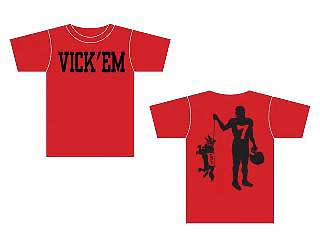Earlier this month, a Texas Tech fraternity found themselves victims of their school's solicitation section of the code of conduct. One of the students in the fraternity was selling t-shirts to raise school spirits for the A&M game. The shirts echoed the (strange) A&M motto "Gig 'Em!" with the more timely "Vick 'Em!" The back of the shirt had a football player wearing the number 7 (Vick's number) hanging the Aggie mascot Reveille by a rope:
 Texas Tech halted the sale of the t-shirts; citing the code of conduct, the school said it doesn't allow the sale of material that is "derogatory, inflammatory, insensitive, or in such bad taste." The student in question argued that he planned to donate part of the profits a local animal defense league because of "Animal Rights, stuff like that." I guess when it comes to obscenity, like Justice Stewart, those administers "know it when they see it."
Texas Tech halted the sale of the t-shirts; citing the code of conduct, the school said it doesn't allow the sale of material that is "derogatory, inflammatory, insensitive, or in such bad taste." The student in question argued that he planned to donate part of the profits a local animal defense league because of "Animal Rights, stuff like that." I guess when it comes to obscenity, like Justice Stewart, those administers "know it when they see it."
Recent comments
2 years 29 weeks ago
2 years 44 weeks ago
2 years 44 weeks ago
2 years 50 weeks ago
3 years 4 weeks ago
3 years 4 weeks ago
3 years 4 weeks ago
3 years 6 weeks ago
3 years 6 weeks ago
3 years 6 weeks ago